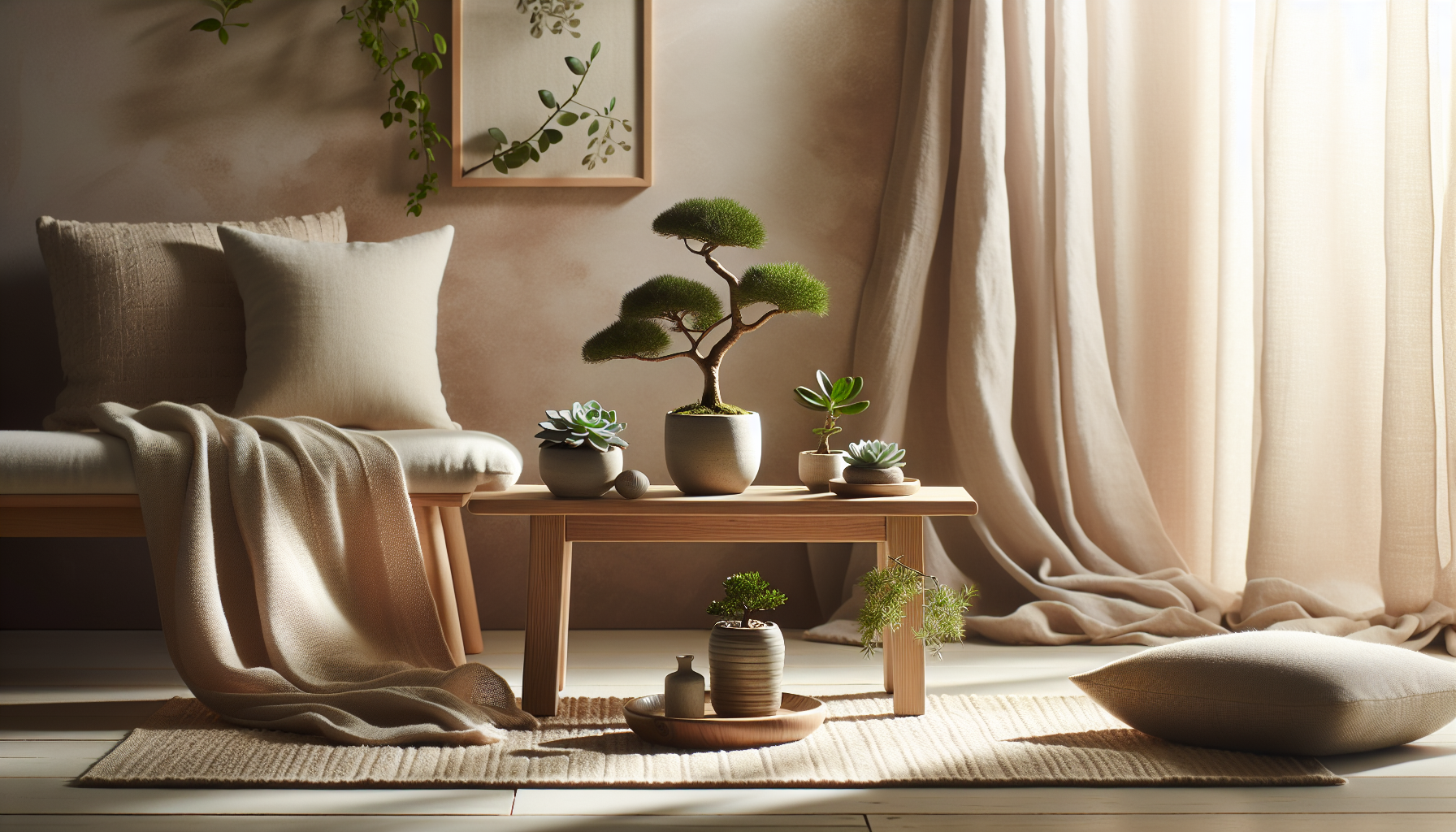What if the harmony of minimalism and nature could enhance your mindfulness practice? Imagine infusing your daily routine with the serene elegance of Japandi design, leading you to a deeper state of awareness and tranquility. Let’s take a closer look at how you can weave Japandi principles into your mindfulness practices.
Understanding Japandi Design
Japandi merges Japanese minimalism with Scandinavian functionality. At its core, this design ethos emphasizes simplicity, craftsmanship, and the beauty of natural materials. You get the best of both worlds: the warmth of Scandinavian styles and the subtle elegance of Japanese aesthetics. But how does this translate into mindfulness? Let’s break it down.
The Philosophy Behind Japandi
Japandi is not just about visuals; it’s a philosophy that celebrates simplicity and intentionality. The Japanese term “wabi-sabi” emphasizes finding beauty in imperfection, while Scandinavian design promotes clutter-free living. Both perspectives invite you to embrace mindfulness in every aspect of life, from your living space to your daily habits.
Minimalism Meets Functionality
In a world overflowing with distractions, Japandi teaches the importance of decluttering—not just your physical space but your mental state as well. Imagine surrounding yourself with fewer belongings that hold more meaning, thereby creating a serene environment that promotes mindfulness.
Japandi-Inspired Mindfulness Practices
Now that you have a foundational understanding of Japandi design, let’s look at specific practices you can incorporate into your daily life to cultivate mindfulness.
1. Create a Tranquil Space
Your environment plays a significant role in your ability to focus and practice mindfulness. A Japandi-inspired space is clutter-free, warm, and inviting. Here are some elements to consider:
- Natural Materials: Utilize wood, stone, and textiles. Bamboo, cotton, and linen can create a comforting atmosphere.
- Neutral Color Palette: Soft tones like taupe, beige, and muted greens encourage calmness.
- Functional Furniture: Invest in multi-purpose items that blend beauty with utility.
By focusing on these elements, you can create a sanctuary conducive to mindfulness.
2. Incorporate Nature
Nature is a crucial component of both Japanese and Scandinavian designs. Bringing elements from the outdoors inside not only enhances your space but also promotes a mindful connection with the environment. Here are some ways to do this:
- Indoor Plants: Incorporate greenery such as succulents or bonsai trees that require minimal care yet breathe life into your space.
- Natural Light: Make the most of daylight by keeping windows unobstructed. Natural light helps regulate mood and energy levels.
- Natural Scents: Use essential oils or natural candles with calming scents like sandalwood or lavender to create a soothing ambiance.
Being in a nature-inspired environment can significantly enhance your mindfulness practice.
3. Mindful Breathing
Breath control lies at the heart of mindfulness. Drawing inspiration from Japandi design, you can patch together a breathing routine that emphasizes simplicity and focus.
How to Practice Mindful Breathing:
- Find a Comfortable Position: Sit or lie down in your serene space.
- Close your Eyes: This helps minimize distractions.
- Inhale Deeply: Breathe in through your nose for a count of four.
- Hold: Retain your breath for a count of four.
- Exhale Slowly: Release your breath through your mouth for a count of six.
- Repeat: Continue this cycle for five to ten minutes.
Keeping your breathing simple and rhythmic harmonizes with the Japandi ethos of minimalism and calm.
4. Daily Mindful Rituals
An excellent way to embrace mindfulness is by establishing daily rituals that become your anchors. Japandi can inspire these practices by encouraging simplicity and intentionality.
Examples of Mindful Rituals:
| Ritual | Description |
|---|---|
| Morning Tea | Start your day with a moment of quiet reflection over a cup of tea. |
| Evening Walk | Enjoy a gentle walk outdoors to unwind and connect with nature. |
| Journaling | Spend a few minutes in the evening reflecting on your day and feelings. |
| Mindful Cooking | Prepare meals with intention, focusing on the smells, textures, and flavors. |
Choose one or more rituals that resonate with you. Each can serve as a simple yet powerful practice.
5. Simplify Your Digital Life
In today’s fast-paced world, digital clutter can be just as overwhelming as physical clutter. Japandi principles can help you streamline your digital environment to enhance focus and mindfulness.
Tips for Digital Minimalism:
- Organize Your Digital Space: Keep your desktop and files tidy. Unsubscribe from unnecessary emails and apps to minimize distractions.
- Set Boundaries: Designate specific times for device usage, allowing you to connect more meaningfully with the physical world around you.
- Mindful Consumption: When consuming content, be intentional. Choose resources that inspire and uplift rather than overwhelm.
Streamlining your digital life can free up mental space, allowing for greater focus on what truly matters to you.
6. Engage in the Art of Tea
The Japanese tea ceremony, or “chanoyu,” embodies mindfulness through ritual and simplicity. While you may not need to follow the formal structure, you can still incorporate its principles into your tea routine.
Steps for a Mindful Tea Experience:
- Choose Your Tea: Select a type that resonates with you, be it green tea, herbal tea, or somethingelse.
- Set the Scene: Find a quiet spot without distractions.
- Prepare Your Tea with Intention: As you boil the water and steep the tea, focus on each movement.
- Savor the Experience: Take your time to enjoy each sip. Notice the aroma, warmth, and flavor.
This mindful tea practice allows you to slow down and appreciate the present moment.
7. Mindful Movement
Whether it’s yoga, tai chi, or simply stretching, incorporating mindful movement can bring you a deeper sense of awareness. Reflecting the Japandi aesthetic, these practices focus on fluidity and balance.
Examples of Mindful Movement Practices:
- Yoga: Emphasizes breath and presence, allowing you to connect deeply with your body.
- Walking Meditation: Find a serene path and walk slowly, focusing on the sensation of each step.
- Tai Chi: A gentle martial art that promotes harmony through slow, deliberate movements.
Whichever practice you choose, let it be a space where you can reconnect with yourself.
8. Less is More: The Art of Letting Go
In a Japandi-inspired mindfulness journey, one vital lesson is letting go of excess—emotionally, physically, and mentally. Reflecting on what truly matters is essential for mindfulness.
Steps to Practice Letting Go:
- Identify Clutter: This could be possessions, negative thoughts, or unhealthy relationships.
- Reflect: Consider what makes you feel fulfilled and what does not.
- Release: Whether that means decluttering a physical space or releasing emotional baggage, allow yourself to let go.
Adopting this mindset aligns beautifully with the Japandi theme of simplicity and intentional living.
9. Embrace Silence
In a world filled with constant noise and distractions, embracing silence can significantly enhance your mindfulness practice. Silence can be incredibly refreshing and restorative.
Ways to Incorporate Quiet Time:
- Silent Mornings: Begin your day without screens or distractions. Allow for a peaceful start.
- Nature Retreat: Spend time in a quiet park or garden, paying attention to the sounds of nature.
- Meditation: Practice seated meditation in silence, focusing on your breath or a calming mantra.
Taking time for silence helps you cultivate awareness and inner peace.
10. Reflect and Journal
Adopting reflection as a regular practice enhances your ability to remain grounded and present. Journaling allows you to document your thoughts and emotions, leading to deeper insights.
Journaling Prompts to Consider:
- What are three things you are grateful for today?
- How did you practice mindfulness today?
- What emotions did you experience, and why?
By reflecting through journaling, you can solidify your mindfulness journey while aligning with the conscientious simplicity of Japandi.
Conclusion: Crafting Your Mindful Journey
As you begin to weave Japandi principles into your mindfulness practices, remember that simplicity is key. Evaluate your environment, routines, and emotional states, and embrace the art of living mindfully. Each small step toward incorporating these elements can lead to profound transformations in your life.
Incorporating Japandi-inspired mindfulness practices can help you cultivate a lifestyle characterized by intention, clarity, and peace. With each mindful moment, you’re not just creating a calming environment—you’re creating a way of life that resonates with your deepest values and aspirations. Continue to absorb these practices as you move forward on your journey, and you may find that clarity, contentment, and a deeper sense of purpose are within your grasp.
Enjoy the process, and let your mindful journey unfold in your unique way!

